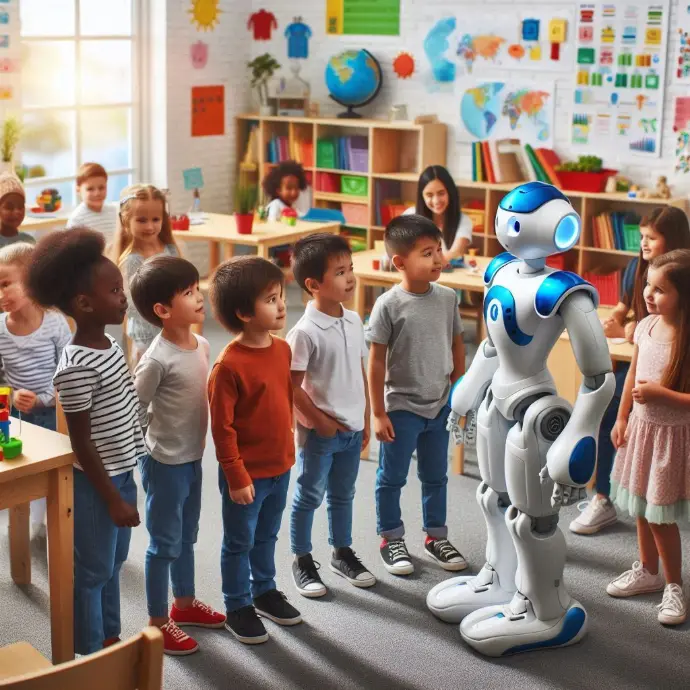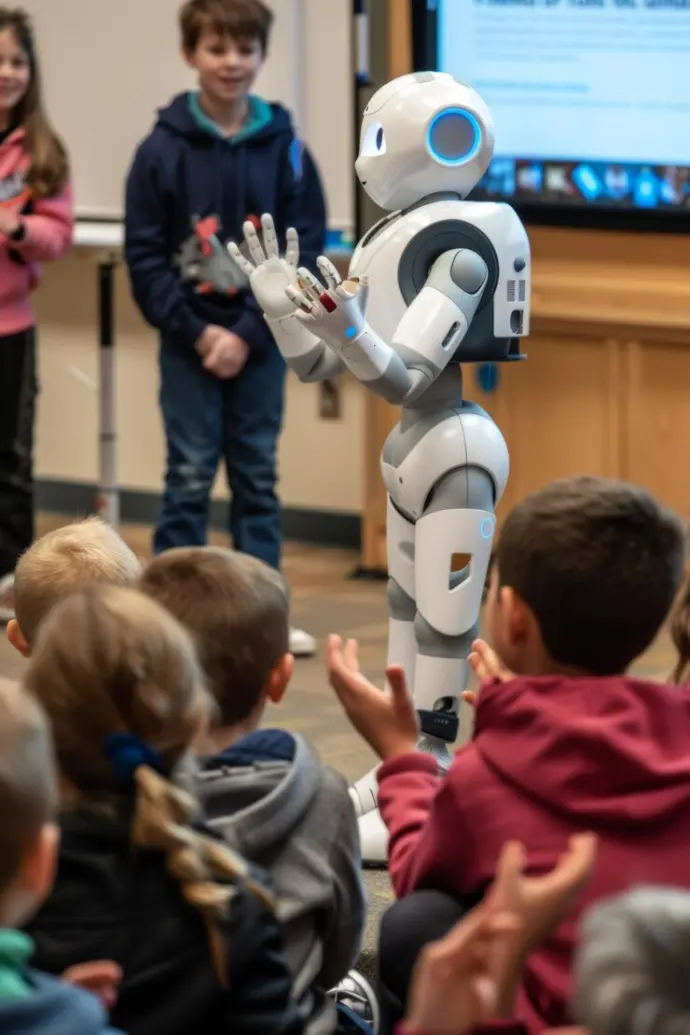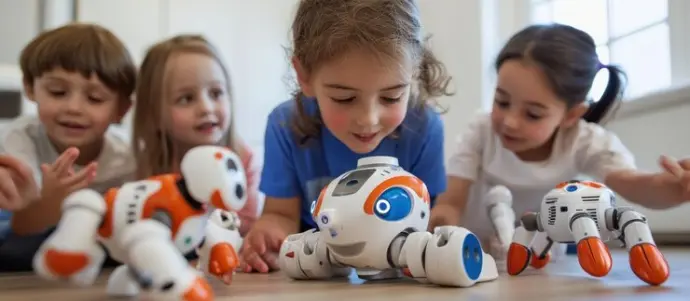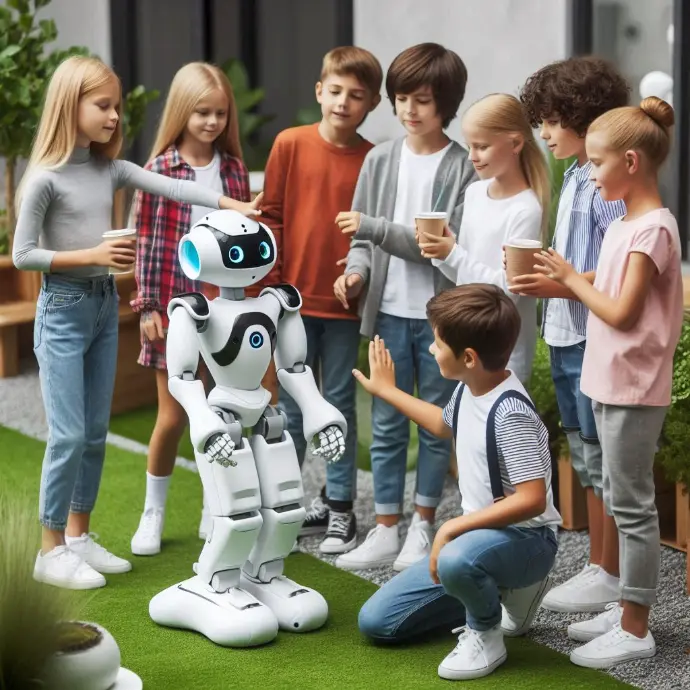Growing Up Alongside Machines: How the Relationship between Humans and Robots Shapes Contemporary Childhood




In the keynote titled "Growing Up Alongside Machines: How the Relationship between Humans and Robots Shapes Contemporary Childhood," we explore how the connection between humans and robots is revolutionizing childhood today. Have you considered how this relationship will influence our children's future? Read on to find out!
Introduction
The relationship between humans and robots is a continuously evolving field that significantly impacts contemporary childhood. With the advancement of technology, it becomes essential to recognize both the advantages and obstacles that such interaction can pose to children's development. Examining these wonders and complexities is vital to understanding the role robots play in children's lives today.
The impact of human-robot interaction on childhood is undeniable. Robots are increasingly integrated into children's daily routines, ranging from interactive toys to learning support tools in educational settings. This interaction from an early age can affect how children view technology, as well as their social and emotional development. The inclusion of robots during childhood also raises important questions about privacy, safety, and ethical issues related to the use of technology among young people.
A critical analysis of the impact of human-robot interaction on childhood is essential, as this can lay the groundwork for future research and policies related to the incorporation of technology into children's lives.
Human-robot connection can offer a variety of substantial benefits for children's development. For example, robots can be used as educational tools to teach complex concepts in a more understandable and engaging way for children. Interaction with robots can also promote essential skills such as problem-solving, creativity, and teamwork.
Furthermore, for children with special needs, robots can play a key role in facilitating treatment and providing emotional support. Various studies have indicated that interaction with certain robots can contribute to improved communication and social skills in children with autism spectrum disorders, for example. These benefits demonstrate the transformative potential of human-robot connection in child development.
It is essential to continue researching and deepening our understanding of the benefits of this interaction in order to optimize its use in educational and therapeutic contexts.
Despite the obvious benefits, human-robot connection in childhood also faces considerable challenges. For example, there is concern that an overreliance on technology can negatively impact children's ability to socialize with each other and their surroundings. Furthermore, the privacy and security of children's personal information are increasingly critical issues in a context where robots continually collect data about their users.
The lack of clear regulations and rapid technological evolution also pose significant challenges regarding human-robot interaction in childhood. Addressing these challenges is essential to ensuring a safe and ethical environment for children who interact with robots in their daily lives.
Human-robot interaction in childhood presents a series of challenges that must be addressed holistically to ensure a safe and beneficial environment for children's development in the digital age.
The Influence of Human-Robot Interaction on Cognitive Development
Interaction with robots can play a vital role in fostering social skills during childhood. Through communication with these devices, children have the opportunity to practice skills such as language, teamwork, empathy, and emotional understanding. The ability to interact and collaborate with a robot can increase their self-esteem and improve their relational skills, benefiting both their childhood and adult life.
Since robots are considered impartial entities, they provide children with a protected environment to hone their social skills without the risk of rejection or criticism, which is particularly beneficial for those who experience obstacles in social interaction with their peers.
Additionally, interaction with robots can educate children about the importance of treating everyone with dignity, regardless of their appearance or ability, fostering inclusion and appreciating diversity in the social environment.
Interaction with robots can also promote logical thinking and problem-solving skills in children. By participating in activities such as programming movements for a robot or solving puzzles with the help of a robot, children strengthen key cognitive skills such as logic, sequencing, and problem-solving.
This early introduction to programming and computational logic can lay the groundwork for greater interest in STEM (Science, Technology, Engineering, and Mathematics)-related careers in the future, something that is essential in an increasingly technology-centric world.
Furthermore, interaction with robots can help children understand abstract concepts and apply logical thinking in everyday situations, giving them an advantage in their academic development and future career paths.
Interaction with robots can significantly influence children's creativity. By playing with robots, children have the opportunity to imagine different scenarios, create narratives, and experiment with various forms of interaction. This fosters creativity, imagination, and artistic expression, essential aspects for children's holistic development.
Robots that stimulate creativity, such as those that allow customization or innovative programming, can motivate children to explore new ideas, think outside the box, and express their individuality through their interaction with technology.
Furthermore, connecting with creative robots can help children acquire skills to solve problems in unconventional ways, consider diverse perspectives, and find innovative solutions to difficulties, which is essential in an environment that is constantly changing and evolving.
Exposure to robots during childhood can play an important role in developing problem-solving skills. Children who engage in activities that involve programming and operating robots have the opportunity to face challenges that require logical thinking, creativity, and persistence. When programming a robot to perform a specific task, children must break the problem down into more manageable steps, identify potential solutions, and experiment with different approaches. This experience not only provides them with technical skills but also promotes resilience and the ability to approach problems methodically.
Additionally, problem-solving through interaction with robots can help children develop critical thinking skills. In situations where the robot does not behave as expected, children must assess the situation, identify possible faults, and modify the code or instructions to correct the problem. This ability to reflect, evaluate, and make adjustments is crucial for developing problem-solving skills within a constantly changing technological context.
Exposure to robots in childhood gives children the opportunity to cultivate problem-solving skills in a practical and enjoyable way. These skills are not only vital for achieving success in technology-related areas, but are also valuable in multiple facets of daily life, equipping children to effectively face adversity throughout their development.
Human-Robot Interaction and Its Emotional Impact on Children
Developments in robotics and emerging technologies have led to a considerable increase in human-robot interaction, particularly in children's contexts. This interrelationship has not only changed the way children play and learn but has also generated significant debates about its emotional and psychological influence. In this context, it is essential to investigate how human-robot interaction shapes contemporary childhood and its emotional development.
The development of emotional bonds with robots has emerged as a notable phenomenon in today's childhood. By interacting with robots designed to foster emotional connections, children can forge authentic emotional bonds. This interaction has the potential to impact children's views on empathy, friendship, and emotional understanding, which in turn affects their perception of the world and their relationships with others.
Research has shown that children are capable of forming emotional bonds with robots, attributing human qualities to them and responding to their stimuli in a way comparable to that they would with other children. This phenomenon raises crucial questions about the role robots play in children's emotional and social lives, as well as the long-term impact these bonds could have on their emotional development.
In an environment increasingly saturated by the presence of robots in educational spaces and homes, it is essential to understand the nature of these emotional bonds to comprehensively address the impact of human-robot interaction on childhood.
Interaction with robots can affect children's ability to understand and express emotions, as well as their development of empathy. By interacting with robots that are designed to express emotions and react to those of children, children can strengthen their emotional understanding and their ability to empathize with others.
Furthermore, interactions with robots can provide a safe environment where children can practice expressing and regulating their emotions, which is especially relevant in a context where children's emotional health is at the center of public attention. This element highlights the urgency of further research into how human-robot interaction can influence children's emotional development and their ability to relate to others in an empathetic and understanding manner.
In this context, communication with robots not only offers new possibilities for children's learning and emotional development, but also presents ethical and psychological dilemmas that require thorough analysis by caregivers, teachers, and technology developers.
Interaction with robots has the potential to affect children's emotional regulation by providing them with resources to recognize, verbalize, and manage their emotions. Robots designed to assist children in managing challenging situations or to facilitate the open expression of their feelings in an unbiased manner can have a significant impact on the development of fundamental emotional competencies.
Furthermore, the inclusion of robots as playmates or as facilitators of educational activities can play an important role in creating emotionally safe and enriching environments for children, which, in turn, positively impacts their emotional well-being and socio-emotional growth.
It is crucial to understand how interaction with robots affects children's emotional regulation, as well as their ability to manage and moderate their emotions in various situations. This understanding is vital to maximizing the benefits of the human-robot relationship during childhood and to reducing potential dangers associated with inappropriate or unethical use of this technology.

The Ethics of Human-Robot Interaction in Childhood
Today, interactions between children and robots raise important ethical questions related to privacy and safety. As children interact with robots in domestic, educational, and recreational contexts, ensuring the protection of their personal data is essential. Smart devices and robots collect a considerable amount of information about children's interactions, raising concerns about privacy and potential online dangers. Robust safety protocols must be established to safeguard children's privacy and ensure that human-robot interactions occur in safe and secure spaces.
Furthermore, physical safety is a key consideration in interactions between children and robots. Robots intended to interact with children must adhere to rigorous safety standards to prevent injuries or incidents. The implementation of rapid detection and response technologies is crucial to ensuring a safe environment for children interacting with robots, whether at home, in educational institutions, or in public places. In this context, developers, manufacturers, and regulatory authorities have an obligation to establish clear guidelines regarding privacy and safety in interactions between children and robots, ensuring the protection of children's rights and well-being in an increasingly digital and automated world.
Human-robot interactions in childhood also raise important questions about the development of principles and values in children. With the increasing use of robots as playmates, educational tools, and home assistants, it is vital to reflect on how these interactions influence children's perceptions and behavior.
Parents, educators, and robot designers have a crucial role in promoting positive principles and values in human-robot interactions. Clear guidelines must be established on the ethical treatment of robots, fostering empathy, respect, and responsibility in children's interactions with these technologies. Furthermore, it is essential to provide children with a proper understanding of the capabilities and limitations of robots, thus promoting a critical and reflective attitude toward their use.
Establishing principles and values in interactions with robots not only contributes to the ethical development of children but also forms the basis for harmonious and respectful coexistence between humans and machines in future society.
The relationship between humans and robots during childhood has a considerable influence on the development of children's identity and worldview. As robots become more integrated into children's daily lives, it is essential to examine how these interactions affect their emotional, social, and cognitive development.
Robots can take on different roles, whether as playmates or as educational guides, raising questions about how these experiences influence children's self-esteem, independence, and worldview. Interaction with these devices can also affect the construction of cultural identity and the appreciation of diversity, particularly in contexts where robots represent diverse gender, racial, or cultural identities. For researchers and educators, it is vital to thoroughly examine the impact of human-robot interaction on identity and worldview formation during childhood, with the goal of fostering healthy and equitable development in an increasingly technological and automated environment.

The Future of Human-Robot Relationships in Childhood
The relationship between humans and robots in childhood is an area that continues to progress, with technological advances that are redefining how children relate to technology. These innovations range from educational robots that teach science, technology, engineering, and math concepts to robotic assistants that provide emotional support to children. These new technologies are revolutionizing the childhood experience and raising questions about the role of robots in children's daily lives.
Advances in human-robot relationships are opening up new opportunities for children in education and recreation. Programmable robots allow children to acquire programming and problem-solving skills in dynamic and engaging ways. Likewise, robots created for entertainment and social interaction can provide companionship and stimulate children's creativity in ways that were not previously possible.
The human-robot relationship also presents challenges and crucial factors related to child development and well-being. It is essential to consider the ethical and psychological repercussions associated with the increasing incorporation of robots into children's lives, ensuring that these technologies are used safely and beneficially for their development.
Technological advances in human-robot interaction are reshaping the way children interact with technology. From educational robots that teach science, technology, engineering, and math concepts to robotic companions that offer emotional support, these innovations are creating new possibilities for childhood education and entertainment.
Programmable robots give children the opportunity to acquire coding and problem-solving skills through an interactive and engaging approach. Furthermore, robots focused on play and social interaction can provide companionship and stimulate children's creativity in ways previously unimaginable.
The human-robot relationship also introduces significant challenges and aspects related to children's development and health. It is vital to consider the ethical and psychological implications of the increasing presence of robots in children's lives, ensuring the safe and favorable implementation of these technologies for their growth.
The possible future scenarios and applications of human-robot interaction in childhood are broad and exciting. As technology advances, the use of robots in educational and recreational settings for young children is likely to increase. Robots intended for education could take on a more prominent role in teaching scientific and technical subjects, while companion robots could offer emotional and social support to children.
Additionally, advances in artificial intelligence could facilitate deeper personalization of human-robot interaction, allowing these devices to be tailored to the specific needs of each child. These advances have the potential to enrich childhood experiences, creating new opportunities for learning and personal development.
However, it is imperative to carefully evaluate the potential effects of these technologies on children, implementing an approach that addresses issues of privacy, safety, and children's emotional well-being. Responsible design and implementation of human-robot interaction are crucial to ensure that these innovations benefit children in a safe and healthy way.
The proper and safe development of human-robot interaction in childhood requires careful consideration of various factors. It is essential to examine the ethical and psychological implications of the increased presence of robots in children's lives, ensuring that these technologies are adopted safely and contribute positively to children's development.
Furthermore, it is crucial to establish precise guidelines for the design and application of robots intended to interact with children, addressing concerns related to privacy, safety, and emotional well-being. Cooperation between child development professionals, educators, engineers, and technology designers is essential to ensure that these innovations meet the highest safety and ethical standards.
At the same time, it is vital to promote continued research on the effects of human-robot interaction in childhood, with the goal of better understanding how these technologies can influence children's cognitive, emotional, and social development. This research is essential to guide the evolution of policies and practices surrounding human-robot interaction, ensuring that these technologies contribute constructively to children's lives.
Conclusions
The relationship between humans and robots in childhood is attracting increasing interest and discussion in the technological and educational fields. With the proliferation of robots in educational and residential spaces, it is essential to examine the effect this relationship can have on child development.
It is clear that the relationship between humans and robots can provide distinctive opportunities for learning, socialization, and entertainment for children. However, it also presents significant challenges in areas such as privacy, ethics, and emotional development. It is crucial to address these concerns thoughtfully and carefully to ensure that the human-robot relationship during childhood is both beneficial and safe.
In this context, it is imperative to continue research and discussion on this issue in order to establish clear and effective guidelines for human-robot interaction in children's environments. Only through a collaborative and multidisciplinary approach can we ensure that children fully benefit from emerging technologies in a safe and positive manner.
For parents, it is essential to be actively involved in their children's experiences with robots, setting defined limits and promoting balanced and responsible use of this type of technology. Open and clear communication about the advantages and disadvantages of human-robot interaction is vital to guiding children in its use.
Educators have an obligation to incorporate human-robot interaction meaningfully into education, ensuring that robot activities foster learning, creativity, and critical thinking. It is also essential to consider ethical and privacy issues when using technology with students.
Finally, technology developers must create robots that are safe, ethical, and respectful of children's development. Privacy and security must be cornerstones in the design and implementation of human-robot interaction, and transparency regarding the operation of such systems must be encouraged.

 IHRO NEWS
IHRO NEWS